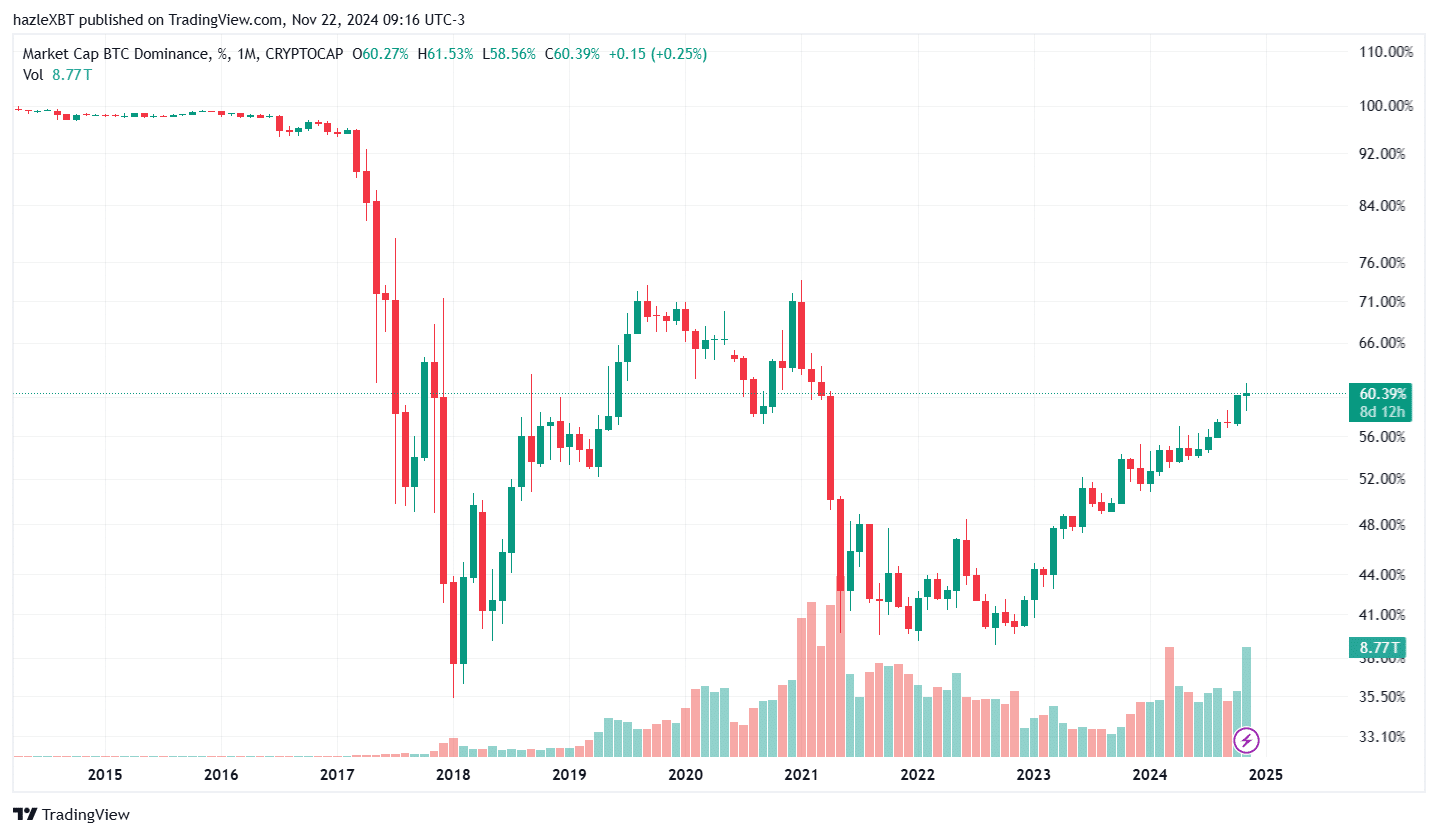Since its inception, the crypto scene has been dominated by Bitcoin on a larger scale. Bitcoin Dominance (BTC.D) is a crucial metric that measures Bitcoin’s share of the total cryptocurrency market capitalization. It serves as a barometer of Bitcoin’s market influence and helps investors understand market trends and capital movements.
Whether predicting the rise of altcoins or gauging investor sentiment, BTC dominance still plays a central role in market dynamics. This article explores in detail what BTC dominance is, its impact on the broader crypto market, and what happens when it moves in one direction or the other. Let’s go;
What is Bitcoin Dominance?
Bitcoin Dominance is Bitcoin’s market share of the entire crypto market capitalization. It is calculated by dividing the market capitalization of Bitcoin by the total market capitalization of all cryptocurrencies and multiplying it by 100.
For example: If the market cap of Bitcoin is $500 billion and the total market cap of crypto is $1 trillion, BTC dominance would be: BTC dominance = (500 billion / 1 trillion) × 100 = 50%
This metric highlights Bitcoin’s position as the leading cryptocurrency and serves as a barometer of its market influence. Historically, Bitcoin dominated over 90% of the market in its early years, but with the rise of altcoins like Ethereum, Ripple, and Solana, its dominance has seen major ups and downs over the years.


Bitcoin’s current dominance is around 60%, which means that Bitcoin accounts for 60% of the market share of the total cryptocurrency market capitalization, valued at $3.3 trillion. According to data provided by Coinmarketcap, the market capitalization of Bitcoin currently stands at almost $1.95 trillion.
How Bitcoin Dominance Affects the Crypto Market
Bitcoin Dominance plays a vital role in shaping the dynamics of the crypto industry. It has been considered a key indicator of upcoming trends such as the Bitcoin bull run, alt season, and crypto capital rotation. It is essentially an indicator of where market participants are focusing their attention and funds. Here are some key areas where Bitcoin dominance is becoming very important:
Market Sentiment
Strong Bitcoin dominance generally indicates that investors prefer Bitcoin as a safer or more stable option, especially in times of uncertainty. This may mean a reduction in speculative interest in altcoins.
Performance of Altcoins
When Bitcoin’s dominance increases, altcoins often underperform as more capital flows into Bitcoin rather than other cryptocurrencies. Conversely, this suggests strong demand for Altcoins relative to Bitcoin when dominance wanes.
Risk appetite
A decrease in BTC dominance indicates a higher risk appetite among investors. In such periods, investors usually allocate a high amount of funds to riskier and higher-rewarding altcoins.
What happens when Bitcoin dominance wanes
Bitcoin dominance sees a significant decline as capital moves out of Bitcoin and into altcoins. In this phase, the altcoin market grows disproportionately faster while Bitcoin rests and follows slight market movements.


The chart above clearly shows that when Bitcoin’s dominance declined, the altcoin’s market capitalization saw a remarkable increase. The first major increase in altcoin market capitalization occurred between 2016 and 2018, when the price of Bitcoin exceeded $10,000 for the first time. Altcoin’s second sharp rise occurred just after Bitcoin hit a new all-time high of $63,500 in April 2021.
At a time when Bitcoin’s dominance is waning, altcoins are seeing massive price gains as traders focus on them. This also increases market volatility as most short-term investors reallocate their capital en masse to alternative crypto assets.
Bitcoin’s diminishing dominance also temporarily diminishes Bitcoin’s role as the primary driver of the crypto market. This suggests that a sharp decline in Bitcoin dominance is not always positive, as it is a clear indication that interest in Bitcoin or the broad crypto market has not been sustained.
What is Altseason and how it relates to Bitcoin dominance
Altseason, short for “altcoin season,” refers to a period in which altcoins significantly outperform Bitcoin in terms of price growth and market share. This phase usually occurs after investors have made profits on Bitcoin price gains and transferred their capital to altcoins. This is also a common occurrence during bull market cycles.
Additionally, the altseason could also be triggered by sudden technological advancements such as the launch of innovative projects or major upgrades in the DeFi space. One of altseason’s key indicators includes top altcoins like Ethereum (ETH) outperforming Bitcoin.
Altseason is also driving a notable increase in the market cap of smaller altcoins while intensifying social media buzz around new and emerging crypto projects.
Conclusion
Bitcoin Dominance is a powerful indicator that provides insight into the health and trends of the cryptocurrency market. When dominance is high, Bitcoin typically leads the market, but when dominance decreases, it can signal the start of a new season – where altcoins take center stage. Understanding these dynamics helps traders and investors make informed decisions and capitalize on market opportunities.
Also read: Next Bitcoin: which cryptocurrency has the greatest potential?

